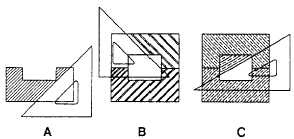|
In view of the vast numbers of different materials,
and since drawings must always identify
materials by lettered form, such as notes, it
is usually more desirable, and it is common practice,
to use a general purpose symbol for section
lining. The general purpose symbol is the cast
iron symbol shown in figure 5-34, view A. The use of other symbols, then, should be limited to
those situations when it is truly desirable, or conventional,
to graphically differentiate between materials.
For example, in an assembly drawing (a
drawing showing different papers fitted together),
it is often desirable to differentiate materials.
On a regular multi-view section, section lining (sometimes
called diagonal hatching or crosshatching) should
be drawn at 45 to the horizontal,
as shown in figure 5-34, view A. However,
if section liners drawn at 45 to the

Figure 5-34.-Diagonal hatching on separate sectional surfaces
shown in normal position.
horizontal would be parallel or perpendicular (or nearly
so) to a prominent visible outline, the angle should
be changed to 30, to 60, or some other angle.
If two adjacent sectioned surfaces are shown,
the hatching should be in opposite directions,
as shown in figure 5-34, view B. If still a
third surface is included, it should be hatched at
another suitable angle to make the surface clearly
stand out separately from the other surfaces
(figure 5-34, view C). Note that the hatching
lines on one surface are not permitted to
meet those on an adjacent surface.
In drawing section lining, use a sharp, medium-grade
pencil (H or 2H). Space the lines as
uniformly as possible by eye. As a rule, spacing
of the lines should be as generous as possible,
yet close enough to distinguish the sectioned
surface clearly. For average drawings, space
the lines about 3/32 in. or more apart.
Diagonal hatching on an auxiliary section should
be drawn at 45 degrees to the horizontal, with
respect to the section. Figure 5-35 shows this rule.
In a revolution or other view of an object in other
than the normal position, the diagonal hatching
on a section should be drawn at 45
degrees to the horizontal or vertical axis of the object
as it appears in the revolution. Figure 5-36 shows
this rule.
|


|







